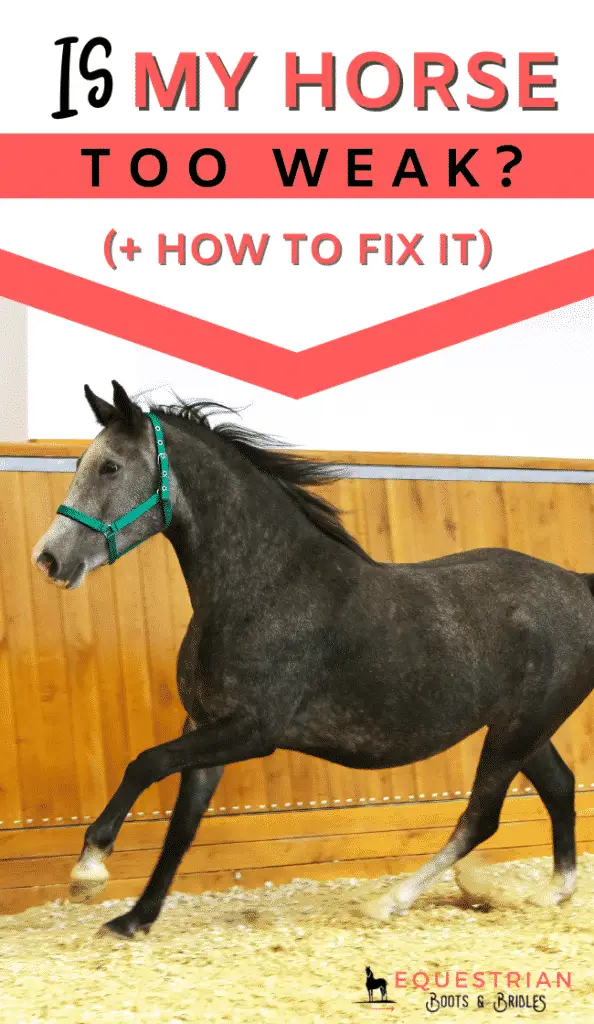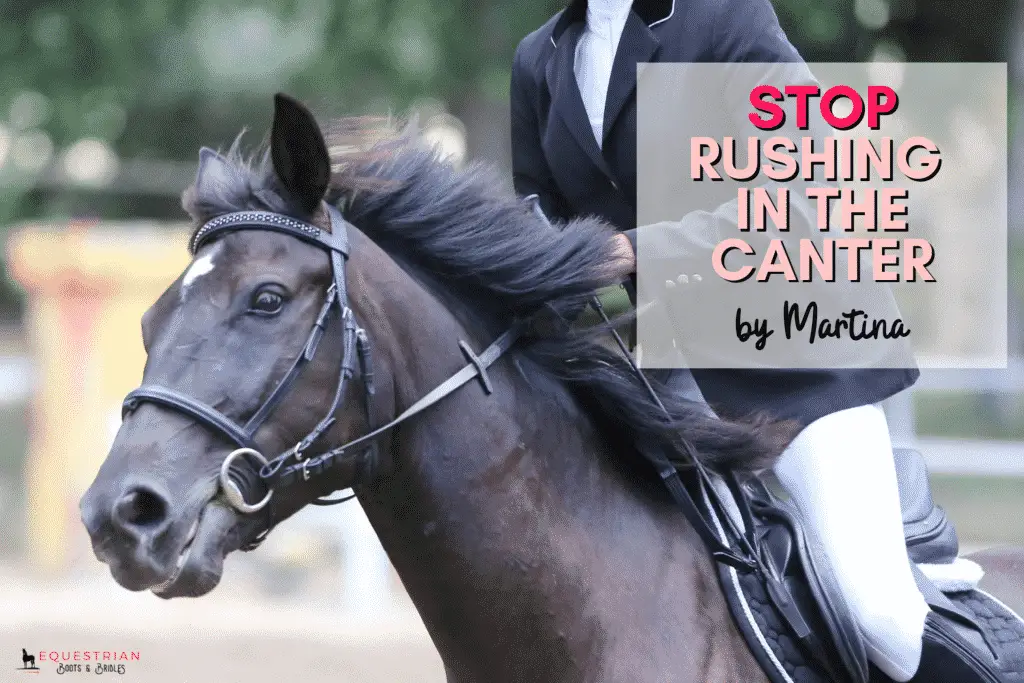In order to slow down a horse’s canter both for flat work and when jumping, it’s important to know why the horse is going so fast. There are various reasons that a horse might be rushing. I break them down into what I’ve experienced to be the three most common reasons here: 3 Reasons Your Horse Is Rushing & How to Fix It
Please be sure to read through that post first if you’re not entirely sure why your horse is going super fast.
This post covers reason #3 which usually surprises people. The reason is that your horse actually IS NOT strong enough to support himself and you properly.
I also talk a lot more more about slowing down forward horses and how to implement something called The Emergency Break in my FREE Beginner Rider’s EBook: The Beginner Rider’s Ebook.
So, how do you stop a horse from rushing the canter? You make that horse horse stronger and more balanced. We’ll cover how to do this below!
The concept that your horse might be going too fast because they are too weak might be counter-intuitive for you. I know that it was not immediately obvious to me.
If my horse is not strong enough, wouldn’t he be going slower?
And the surprising answer is no.
Without the proper strength over the topline and in the hindquarters, a horse can’t balance himself around turns and so what ends up happening is that he’ll start “falling forwards” and speeding up.
I’ve ridden 2 horses in my life that were noticeably weak: Dash and Rudy.
Dash was a reactive Arabian who could not balanve himself in the canter therefore he would almost be constantly falling forwards and leaning in. I always felt like he would just fall over to the inside and his legs would come out from under him, that’s how side-ways he was.
Rudy is my young warmblood cross who is only 4 and hasn’t had an opportunity to build up his strength yet. He rushes in the canter on turns because he just can’t quite balance and support himself well around bends yet.
How Do I Know If My Horse is Too Weak?

There are three signs that your horse is too weak to canter nicely:
- Your horse swings way out to the outside on turns when cantering and feels like he might fall over.
- Your horse has a “hollow” back or a “sway” back. This is usually not as obvious as the extreme pictures on Google make it out to be.
- Your horse leans on the reins all the time and you feel like if you were to give him a loose rein, he would just fall over.
Furthermore, I’ve noticed that if your horse has other reasons for being too forwards, it will typically start showing up in the trot and those horses are more likely to take you into a gallop. Weak horses seem to really obviously struggle with being too fast at the canter (and therefore while jumping).
Being “too weak” is typically the case with young horses because they just haven’t had time to develop their strength yet. I still have this issue with Rudy when we’re going faster because even though we’re working on it, he hasn’t had the time to get strong enough yet to balance himself. Even on the lunge line, he still struggles sometimes but especially when I’m on his back because of the extra weight.
If your horse is young, the fix I talk about below will still work and in fact it’s really beneficial to build a horse’s strength early on. Just know that weakness in a younger horse is actually quite normal and accept that the canter might not be the way you want it for a year or two while your horse builds up his strength.
What about older horses?
Can I Fix My Older Horse’s Sway Back?
There is a myth that older horses that are hollow-backed can’t be fixed. This is simply NOT TRUE.
Just like it’s true an older person can still go to the gym and get in shape, so can an older horse.
In an older horse, I find that weakness goes along with reactivity. Check back with my post I mentioned at the beginning of the article (3 Reasons Your Horse Is Rushing & How to Fix It) and go to “Reason #2” as you might have to also fix your horse’s anxiety in addition to his strength in order to fully fix the rushing problem. I go more in depth on calming anxious horses here: How to Calm an Anxious Horse.
If you think about it, this makes sense. These horses are not really strong enough to support themselves properly therefore being ridden and asked to do things that are physically challenging is that much more stressful.
So, how do we fix the phyisical aspect in order to slow down our horse’s lope and hopefully make both flatwork and jumping more enjoyable for both ourselves and our horse?
How to Slow Down Your Canter: Exercises to Make Your Horse Stronger & More Balanced

Really it’s 1 exercise to make your horse more balanced but you can do it in a variety of different ways. It’s called “stretching” your horse and don’t worry, it’s not horse yoga!
Stretching down over the topline is something that young horses will do naturally when they are moving forwards with a bend in their body. What this will look like is the horse will have their head all the way down to the ground. A young horse’s nose might even drag in the dirt.
This allows the horse to use his hind-end in an effective manner to propulse him forwards and lift up through his back.
Horses aren’t designed to pull themselves forwards by their front legs. Rather, they should be pushing themselves forwards from their hindquarters.
The way I like to think about horse movement in general is by thinking of squatting. I used to lift weights competitively so for me this works. If you’re not familiar with squatting than think of any physical movement when you’re at the gym. We all know there’s a “right” way and a “wrong” way usually to do most movements at the gym.
You can squat with your back very flexed and your knees coming in and typically this is easier for a lot of people when they’re just starrting out because those muscles are weak.
Another example is pushups. You can do a pushup with your lower back caving in and your bum up in the air and it’s a lot easier than doing it with a stiff body as if you’re holding a plank.
This is the SAME concept with horses.
It’s more challenging for a horse to learn how to move correctly in a way that will allow him to be strong, balanced and able to effectively carry a rider through difficult dressage movements, reigning movements or over jumps.
In the wild, horses move around with their heads down ALL DAY LONG accross huge distances. This allows them to build up that strength. Unforuntatley, once domesticated, smaller paddocks, feeding buckets and hay nets off the ground and being stalled all mean that there is a lot less time spent working those muscles in the topline and hindquarters.
Luckily, we can work on stretching our horses using the techniques outlined by Will Faeber in his Art2Ride.com program. These videos were introduced to me by my coach and they’re literally made such a huge difference.
You can purchase his videos here: https://art2ride.com/premium-video-content/
Please note that I am not receiving any kind of commission or compensation by recommending these videos to you. I 100% believe in them and I’ve bought them myself and use them with Rudy every single time I lunge or ride him.
I would recommend buying all of them but if you’re on a budget, definitely get “Work in Hand: The Riding Master’s Secret” and the first video in the “Training the Young Horse” series as that will give you a basic understanding on how to do the stretching with your horse.
I’m sad sometimes when I think about Dash because I think I could have made a huge difference in his life if I had known about this before. But also, without him, I don’t think I would have ended up learning so much about it. Life works that way sometimes I guess!
I talk more about slowing down forward horses in my FREE Beginner Rider’s EBook. Sign up below and you’ll get it directly to your inbox for free:
Want to learn more about fast horses? This is my entire library of posts just on the subject of “How to Slow Down A Horse”:
- 3 Reasons Your Horse Is Rushing & How to Fix It
- How to Slow A Horse Down Without Pulling The Reins
- How to Slow Down A Horse
- How to Calm an Anxious Horse
Having other issues with your horse? Here’s some other posts I’ve written you might like:
- How to Move A Horse Forward Under Saddle
- The Secret Walk-to-Trot Riding Aid
- How to Sit the Trot
- How to Establish Neck Flexion
- How to Collect a Horse
- How to Ride Without Stirrups
- How to Stop a Bolting Horse
- How to Ask for the Canter
- How to Master Jumping While Minimizing Fall Risk
Happy riding,
Martina
Like this post? Why not share it:



